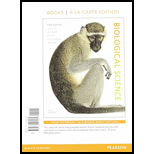
Concept explainers
To review:
The distance from the center where the dormant eggs would be located after a span of two years.
Introduction:
The secondary growth of the plants includes the division of the vascular cambium and the cork cambium. The cork cambium present in vascular plants, a lateral meristem producing cells internally and externally by tangential divisions, is responsible for secondary growth of plants. The vascular cambium is a tissue present in plants between xylem and phloem and produces secondary xylem on the ring’s inside and secondary phloem on the ring’s outside separating the primary xylem and phloem apart. Both of them are involved in the growth in the plant in terms of the increase in the girth of the plants.
Want to see the full answer?
Check out a sample textbook solution
Chapter 34 Solutions
Biological Science, Books a la Carte Plus Mastering Biology with Pearson eText -- Access Card Package (6th Edition)
- Below is a series of pictures of the stem (x.s.) of a sunflower, Helianthus sp. Note that it shows both a young stem and older stem. young 100x (.s.) older 100x (x.s.) Make a sketch of both ages and upload it here with the following structures labeled: epidermis, cortex, pith, vascular bundles, fibers, primary xylem, primary phloem, tracheids, vessel elements, collenchymaarrow_forwardBelow is a series of pictures of the stem (x.s.) of a sunflower, Helianthus sp. Note that it shows both a young stem and older stem. E- young 100x (x.s.) older 100x (x.s.) Make a sketch of both ages and upload it here with the following structures labeled: epidermis, cortex, pith, vascular bundles, fibers, primary xylem, primary phloem, tracheids, vessel elements, collenchymaarrow_forwardHarvest of cork from cork oaks (Quercus suber) is _________________, because it involves targeted (i.e., intentional) removal of the __________________, and the ________ is unaffected. (recall that inner bark = secondary phloem)arrow_forward
- Which of the following is not correct concerning plant xylem? The fluid (sap) in the xylem transports sperm and eggs throughout the plant. The fluid (sap) in the xylem transports water and ions. The fluid (sap) of the xylem moves from the roots toward the leaves of the plant. The xylem is composed of tubular cells that run throughout the stems and leaves of vascular plants.arrow_forwardPrimary xylem... RIGHT WRONG 1°) is a tissue only made up of live cells 2°) has a centrifugal differentiation in the root 3°) is a tissue present in the root 4°) is only found in woody plants O O O O O O O Oarrow_forwardAnother issue for these trees is fire. Giant redwood trees are very adapted to tolerate fire. The mature trees have thick bark which helps them survive most fires. Younger trees are still at risk. The seeds can remain dormant in cones for many years (estimated 20) and germinate best after the cone is exposed to fire. However, highintensity fires (hot temperatures) are risky for seeds and trees of all ages. What are two things you could do to try and mitigate (reduce) the risk of fire damage but still allow for good seed germination in forests?arrow_forward
- Below is a series of pictures of the stem (x.s.) of a sunflower, Helianthus sp. Note that it shows both a young stem and older stem. young 100x (x.s.) older 100x (x.s.) Make a sketch of both ages and upload it here with the following structures labeled: epidermis, cortex, pith, vascular bundles, fibers, primary xylem, primary phloem, tracheids, vessel elements, collenchymaarrow_forwardIn a germinating seed, the downward growth of roots and upward growth of stems are the plant’s responses to gravity. Which statement best describes this phenomenon? * downward growth of roots – positive response to gravity ; upward growth of stems – negative response to gravity downward growth of roots – negative response to gravity ; upward growth of stems – positive response to gravity downward growth of roots – positive response to gravity ; upward growth of stems – positive response to gravity No answer downward growth of roots – negative response to gravity; upward growth of stems – negative response to gravityarrow_forwardSketch side by side two daughter cells formed after mitosis of a meristematic cell in the vascular cambium of a eudicot stem. Label the cell formed toward the interior of the stem a meristematic cell. Should the daughter cellformed toward the outside be labeled primary xylem, primary phloem, secondary xylem, or secondary phloem?arrow_forward
- Below is a series of pictures of the stem (x.s.) of a pine tree, Pinus sp. 40x (x.s.) Make a sketch of 40x and upload it here with the following structures labeled: periderm, cortex, secondary phloem, secondary xylem, vascular cambium, tracheids, resin ducts, Spring wood, Summer woodarrow_forwardBelow is a series of pictures of the stem (x.s.) of a pine tree, Pinus sp.. 40x (x.s.) Make a sketch of 40x and upload it here with the following structures labeled: periderm, cortex, secondary phloem, secondary xylem, vascular cambium, tracheids, resin ducts, Spring wood, Summer wood MacBook Proarrow_forwardMatch the advantage to the correct adaptation. allows plants to transport water and sugars quickly across long distances [Choose] [Choose] seeds xylem and phloem amniotic eggs fruits pollen flowers allows the sperm to travel to the egg safely, without water allows the sporophyte embryo to wait for the right conditions before growing helps seeds disperse to new places when animals cat them [Choose ]arrow_forward

 Biology (MindTap Course List)BiologyISBN:9781337392938Author:Eldra Solomon, Charles Martin, Diana W. Martin, Linda R. BergPublisher:Cengage Learning
Biology (MindTap Course List)BiologyISBN:9781337392938Author:Eldra Solomon, Charles Martin, Diana W. Martin, Linda R. BergPublisher:Cengage Learning Biology: The Dynamic Science (MindTap Course List)BiologyISBN:9781305389892Author:Peter J. Russell, Paul E. Hertz, Beverly McMillanPublisher:Cengage Learning
Biology: The Dynamic Science (MindTap Course List)BiologyISBN:9781305389892Author:Peter J. Russell, Paul E. Hertz, Beverly McMillanPublisher:Cengage Learning Biology 2eBiologyISBN:9781947172517Author:Matthew Douglas, Jung Choi, Mary Ann ClarkPublisher:OpenStax
Biology 2eBiologyISBN:9781947172517Author:Matthew Douglas, Jung Choi, Mary Ann ClarkPublisher:OpenStax



